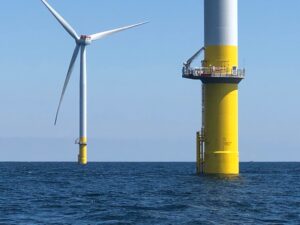
by Bill O’Keefe
The General Assembly, Governor Ralph Northam, and Dominion Energy are proud of their commitment to achieve zero carbon emissions by 2050. Dominion routinely showcases its planned wind farm 27 miles off of the Virginia coast. Before Dominion and the Commonwealth get beyond the point of no return — governments don’t acknowledge sunk costs, opportunity costs or terminate failed programs — they would do well to closely examine the experience with wind power in Germany.
Germany is a leader in the green energy movement and has installed over 30,000 windmills. The German renewable energy program started in 2000. After 20 years, there is a problem. The German wind power industry is suffering setbacks. Hardly any new turbines are being built, and more and more old wind turbines are being phased out. Some of the problems don’t apply to Virginia since they concern on-shore wind mills but there are lessons to be learned.
Many German wind farms are threatened with shutdown. The German Renewable Energy Act, which has been in force since 2000, guarantees wind turbine operators secure subsidies for twenty years. Without subsidies they are no longer profitable. By 2025, there is a risk of 15,000 MW of wind projects will be lost corresponding to over a quarter of Germany’s onshore wind power.
Technically, it would still be possible to continue wind turbines operating after 20 years. But without guaranteed subsidies many operators are finding it difficult to survive in the power generation market. Even at the current price level — 33 cents per kWh which is more than twice what Virginians pay — they are barely competitive. The German wind industry is appealing to the federal government to provide additional financial support to keep the wind farms running. That should sound familiar. Since Dominion has a guaranteed rate of return on its almost $8 billion investment, today’s 12 cents per kWh will surely escalate when there are cost overruns and the unanticipated costs of rethinking and restructuring the entire Virginia electric power system.
Revising the grid to accommodate growth in renewable energy will involve finding a cost-efficient and reliable way to deal with intermittency. Because of a “low wind spring” Germany’s 30,000 wind turbines generated almost a third less electricity in the first quarter of 2021 than last year, the gap was filled by increased electricity generation from coal power and gas. Germany’s move to reliance on weather-dependent renewables is quickly running up against limits — issues that all countries exchanging conventional fuels for wind and solar will eventually face. What happens if there is an unanticipated low wind period along the Atlantic coast or if storm /hurricane winds are too strong for wind mills to operate? Or if the General Assembly reverses its mandate? Has anyone seen a contingency plan?
Will public support 20 years from now remain as strong as it is today? Germany’s experience suggests that it might not when the entire set of realities are understood and the climate catastrophe remains at least another decade in the future. Will the Navy remain supportive if this 170-square-mile wind farm interferes with air and ship operations or provideS a convenient hiding area for submarines?
None of these contingencies may come about. But prudence demands that they be addressed and that the public be clearly informed of how Dominion will respond to a worse-case scenario and what that means for electricity service. The cost and potential consequences are too big for just good faith acceptance of Dominion’s advocacy.
William O’Keefe, a Midlothian resident, is founder of Solutions Consulting and former EVP American Petroleum Institute.

Leave a Reply
You must be logged in to post a comment.